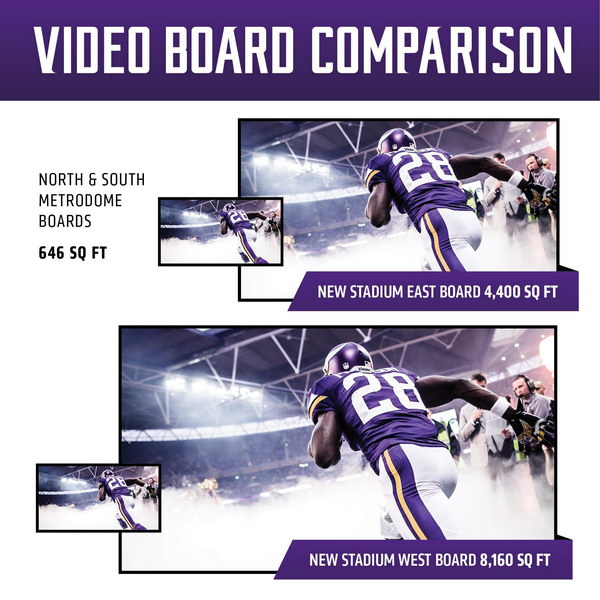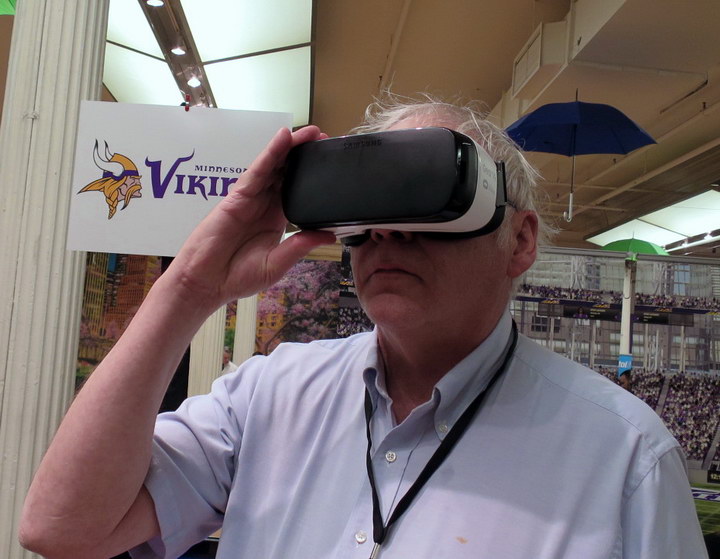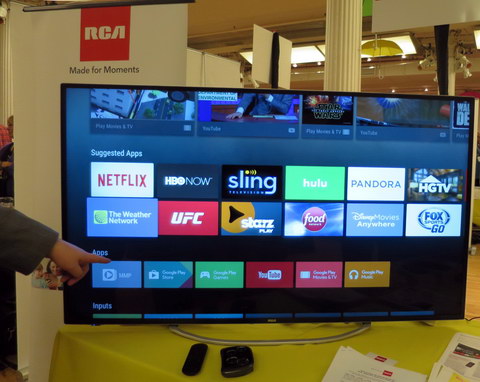I attended a Pepcom media event in New York on April 7th and saw some of the latest technology. Three things, in particular should be of interest to Display Daily readers.
First, the Minnesota Vikings, an American football team, was there exhibiting. This is the first ever sports franchise to exhibit at Pepcom, which is normally more oriented to high technology aimed at consumers. The Vikings were there to talk about their brand new, high technology stadium which is, of course, aimed at consumers, so perhaps it wasn’t that bad a fit after all. They certainly had one of the busiest booths at Pepcom that evening.
The USBank Stadium is scheduled to be open in July, 2016, in time for the fall football schedule. In addition to the Vikings, the stadium will host the 2018 Super Bowl and the 2019 NCAA Final Four basketball tournament. Normal stadium capacity is 66,200, expandable to 70,000 for major events like the Super Bowl.
 A 55’ (16.8M) tall curved LED video board serves as the sail of a Viking Ship outside the stadium
A 55’ (16.8M) tall curved LED video board serves as the sail of a Viking Ship outside the stadium
The stadium is owned by the Minnesota Sports Facilities Authority, a state agency, and is expected to be used for hundreds of events each year. One of the first non-sports events will be a Metallica concert, a month after it opens. The stadium is in the Downtown East section of Minneapolis and is designed for easy access. It is connected to both the Minneapolis light rail system and the 8 mile (12.9 Km) Skyway system of elevated, enclosed walkways designed to protect people from the brutal Minneapolis winter.
Daktronics was the supplier of a total of 18 LED video displays including the marquee Viking ship sail that greets visitors outside the stadium. These displays total 25,000 square feet (2,323 m²) and all displays use Daktronics’ 13HD technology. The largest of these displays is in the west end zone and is 68 feet high by 120 feet wide (20.7 x 36.6M) and will be the focal point of the stadium. A second display in the east end zone is 50 feet high by 88 feet wide (15.2 x 26.8M). While neither of these displays is a record-setter in terms of size, they are much larger than the displays in the Metrodome stadium previously used by the Vikings. There are also several ribbon displays, the largest of which is 2.5 feet high by 1475 feet long (0.8M x 450M).

In addition to the 18 Large LED displays, the stadium will have more than 2,000 television displays throughout the stadium and concourses. A football fan will hardly ever be out of sight of the game.
The stadium is completely equipped with Wi-Fi, designed to accommodate not only the 66,200 fans but also the staff, vendors, etc. According to the Vikings, there is enough bandwidth to allow all 66,200 fans to stream video simultaneously. Burstable bandwidth is said to support up to 2x that number of fans, if necessary for special events such as the Super Bowl. CenturyLink, a global IT and cloud services provider, has a 10 year contract to provide the integrated IP network. This includes 1,300 Wi-Fi access points that will allow the stadium-wide Internet access. CenturyLink will also provide the content distribution to the more than 2,000 high-definition televisions. VenueNext will be supplying an App that ties all Viking functions together, both inside and outside the stadium. Use of Wi-Fi inside the stadium will not be limited to the VenueNext App, however.
Communications within the stadium is not limited to Wi-Fi. A neutral host distributed antenna system from Verizon Wireless is designed to ensure a level playing field for all major wireless carriers. This is said to create reliable, high-speed mobile connectivity for all users.
The stadium will receive Leadership in Energy and Environmental Design (LEED) certification. Part of this comes from the environmentally sound design and construction practices, as well as the recycling of the material from the demolished Metrodome. Another part of the certification comes from the availability of public transit. In addition, the USBank Stadium will be the first NFL stadium to open with LED lighting, consuming 75% less energy compared to a traditional metal halide lighting approach.
Why were the Vikings at Pepcom? Basically, they were so proud of their new stadium and its technology they wanted to brag about it. Part of the bragging involved the use of Oculus VR headsets to let Pepcom attendees see a virtual reality tour of the stadium. The tour consisted of a series of 360° still images of the inside and outside of the stadium. I tried it and could see everything from the long ribbon displays circling the inside of the stadium to the design of the overhead roof truss that helped with the LEED certification to the artificial turf under my virtual feet that the football would be played on. This represents a good use of VR technology – you could really see the new stadium from all angles.
 Matt Brennesholtz using an Oculus VR headset to view the new Vikings Stadium from all angles.
Matt Brennesholtz using an Oculus VR headset to view the new Vikings Stadium from all angles.
Two other things at Pepcom should also be of interest to Display Daily readers. First, Activeon, Inc. announced on April 7th a new line of 4K televisions under the RCA brand name. These units will become available in the US retail market in July. The RCA brand is owned by Technicolor and Activeon is its US licensee for television. Activeon was showing their 55” version at Pepcom, model XLD55G65RQ.
These 4K, 120Hz LED TVs have a built in Android computer, which allows streaming movie or music content, playing of Android games and running other Android apps. Google Cast (previously known as ChromeCast) is built into all models. Google Cast lets you cast entertainment and apps from your phone, tablet or laptop onto your large screen TV. Google Cast works with most popular devices including iPhone, iPad, Android phones and tablets, and computers that are Mac, Windows or Chromebook based. Connectivity includes Wi-Fi (802.11a/b/g/n/ac); Wi-Fi/WPS; Bluetooth; HDMI 2.0 with HDCP2.2 supported; H.265/HEVC; the world’s first VP9 Codec for 4K 60 Hz; and support for USB 3.0.
Perhaps the most notable thing about these 4K TVs is their price: the 50” will be $499, the 55” will be $699 and the 65” will be $999. Premium design versions of the three sets will be available at $599, $799 and $1099 respectively.
 Demonstrating the RCA 4K Android TV at Pepcom
Demonstrating the RCA 4K Android TV at Pepcom
A third booth of interest at Pepcom was Energous Corporation, who showed their WattUp wireless power technology. Most wireless power technology is extremely short range and typically involves placing the device to be charged on a charging mat. The WattUp technology is said to be capable of delivering up to 10W of power to devices within 15 feet (4.6M) of the source. Unfortunately, the Energous representatives undercut their argument at Pepcom by only showing a version of their system that only worked at very short ranges.
Simply radiating power in all directions with a conventional antenna is hopelessly inefficient. Instead, the Energous long-range system works on the basis of a phased-array RF antenna that controls the direction of the radiated power and aims it at the device to receive the power. This type of antenna is flat and has no moving parts. The mock-up home system shown at Pepcom used an antenna that was roughly 9” high by 14” wide (23 x 36 cm). Inside an antenna like this would be many small sub-antennas for the RF power. By controlling the phase of each of the sub-antennas compared to the other sub-antennas, the direction of the emerging beam can be controlled and most of the power is in the beam, not radiated in useless directions. While this is still inefficient compared to wired power, it is efficient enough to be usable for low-power systems like smartphones. The upper limit on radiated power is determined primarily by safety considerations. After all, the RF power beam aimed at your smartphone is also aimed at your head while you use the phone.
In operation, the Energous system will track the device receiving the power and dynamically re-aim the beam to fall largely on the target. In fact, Eregous says it can track multiple handheld devices, up to 4, and deliver 4 watts to each at short range or 1 watt to each at long range.
I talked to Gordon Bell, Sr. Director of Business Development and Marketing Communications at Pepcom. He suggested one possible use would be to build the transmitter into a TV set and direct the power to a hand-held wireless game controller. The beamed power would ensure the battery in the game controller is always fully charged and make it unnecessary for the gamer to ever stop playing to recharge it.
Energous transmitter and receiver
Energous does not plan to manufacture products containing its technology. Instead they plan to license the technology to others. Bell said at Pepcom they have recently signed up a tier-1 consumer electronics company. Energous had previously announced that they had signed agreements with two Tier-1 IoT companies at CES 2016. He expected short-range versions of their system to appear by the end of 2016 and longer range versions to appear by mid-2017. A video demonstration from CES 2015 is available on YouTube. (http://tinyurl.com/z3dva4e) –Matthew Brennesholtz

